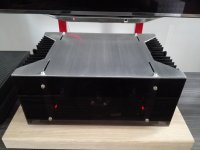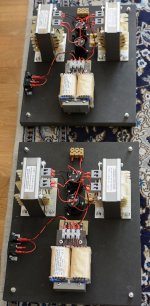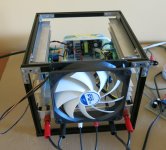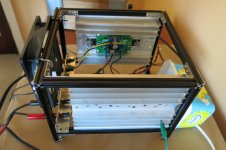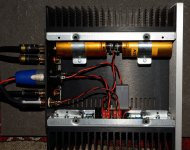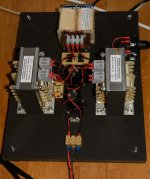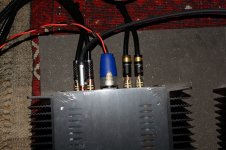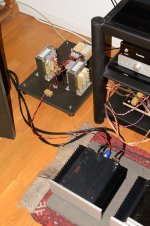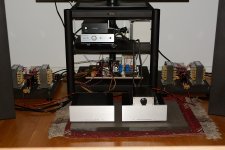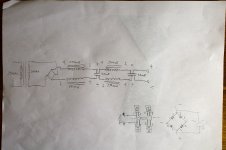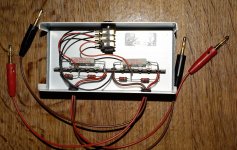That is PBV 0.68 ohm and 0.47 ohm resistance, the power is not on the board, I will use the transformer, rectifier and filter to increase the two stage voltage regulator circuit. You can click here to enter the Chinese Forum.
That's not something I would recommend. It's not the voltage but the amperage. Your average power tube amp tube rectifier is made for high voltage, low current. Low powered as it is, the ACA requires low voltage, high current. Finding a tube that can deliver over 1A of current - and into 10,000uF of capacitance - well good luck with that.
If you do want to build a linear power supply - stick with solid state rectifiers. If you want to make it interesting, put some chokes in there.
I’ve been trying to educate myself on a low voltage rectifier power supply I found this from wu audio low voltage power supply
https://static1.squarespace.com/sta...b4d9d2c/1521134310080/WA7tp_Owners_Manual.pdf
And going back to the early years of AM radios in old vehicles when the batteries and charging systems of a car we’re only 6 V and they use tubes and rectifiers to power these large multi tubed hi current a.m. radios in vehicles.
With my little understanding from what I’ve been reading there’s also a way to slow down and limit the current in a rush so the capacitors do not overpower the tubes by having a large current in rush. With my little understanding from what I’ve been reading there’s also a way to slow down in limit the current in rush so the capacitors do not overpower the tubes by having a large current in rush . I would think a lot of people building the amp camp amp would be interested in building their own linear power supply old school with two rectifiers. I would think a lot of people building the Amp Camp Amp would be interested in building their own linear power supply old school with tube rectifiers
I’ve been trying to educate myself on a low voltage rectifier power supply I found this from wu audio low voltage power supply
https://static1.squarespace.com/sta...b4d9d2c/1521134310080/WA7tp_Owners_Manual.pdf
And going back to the early years of AM radios in old vehicles when the batteries and charging systems of a car we’re only 6 V and they use tubes and rectifiers to power these large multi tubed hi current a.m. radios in vehicles.
With my little understanding from what I’ve been reading there’s also a way to slow down and limit the current in a rush so the capacitors do not overpower the tubes by having a large current in rush. With my little understanding from what I’ve been reading there’s also a way to slow down in limit the current in rush so the capacitors do not overpower the tubes by having a large current in rush . I would think a lot of people building the amp camp amp would be interested in building their own linear power supply old school with two rectifiers. I would think a lot of people building the Amp Camp Amp would be interested in building their own linear power supply old school with tube rectifiers
I have built "old school" PSUs for the ACA and I am in the test phase in the moment. So far the PSUs seems to work as expected but I need more testing before I connect it to the ACA. LCLC filter are used and Schottky diodes for the bridge (not tube rectifiers). There are 4 chokes (2 on each core). They are coupled in the "Lundahl preferred way". It is relative expensive…….but fun.
Attachments
Awesome looks! Really nice design.Finally got it finished, first version of ACA. It have served me really good for some time, now was the time to polish it up. Linear CRC supply.
I have built "old school" PSUs for the ACA and I am in the test phase in the moment. So far the PSUs seems to work as expected but I need more testing before I connect it to the ACA. LCLC filter are used and Schottky diodes for the bridge (not tube rectifiers). There are 4 chokes (2 on each core). They are coupled in the "Lundahl preferred way". It is relative expensive…….but fun.
Hello,
Did you find the right way to connect the choke like the Lundahl. It can only be done in one way.
After that you can start making the connections between the diodes, first choke and transformer a lot shorter.
Greetings, Eduard
Yes, I connected the chokes same way. The current has to go in same direction in the two chokes so both chokes drives the flux in same direction. It was easy to measure the difference using a LCR meter. I get either 1.2 H or close to 0 H depending on how the two chokes are coupled in series (in phase or reverse phase).
One PSU is connected to the ACA in the moment. It is about 23.8 VDC after warm up. So it seems the calculations worked. The Schottky diodes temperature is about 75 C with an ambient temp at 26 C. It is a bit high but well inside max. limit which is 175 C.
The "only" problem I see to far is that the unloaded voltage is about 33 VDC (with 2 x 470 ohm bleeder resistors). The ACA is not an ohmic load but load is high until MOSFET is conducting. So during inrush the voltage goes to about 34-35 VDC and then goes down to 23.5 during the first 2 sec. or so. Then after warmup the voltages settles to about 23.8 VDC. The high inrush voltage may or may not be a problem. The capacitors are fine (they are all 35V or higher rating) and if the FETs can handle it......it is probably OK.
One PSU is connected to the ACA in the moment. It is about 23.8 VDC after warm up. So it seems the calculations worked. The Schottky diodes temperature is about 75 C with an ambient temp at 26 C. It is a bit high but well inside max. limit which is 175 C.
The "only" problem I see to far is that the unloaded voltage is about 33 VDC (with 2 x 470 ohm bleeder resistors). The ACA is not an ohmic load but load is high until MOSFET is conducting. So during inrush the voltage goes to about 34-35 VDC and then goes down to 23.5 during the first 2 sec. or so. Then after warmup the voltages settles to about 23.8 VDC. The high inrush voltage may or may not be a problem. The capacitors are fine (they are all 35V or higher rating) and if the FETs can handle it......it is probably OK.
I like the current state! Perhaps the margarine case is a bit excessive, but otherwise it looks great! 
Two questions:
- Do you really require the fan? What temperatures are you reading?
- Do you find the fan adds hum, or wobble or any other side effect?
I ask because my heatsinks are a bit under-specifications, so the fan may be required for my setup, but I would hate to add noise to a perfectly clean amp.
Thanks for any feedback, best regards,
Rafa.
Two questions:
- Do you really require the fan? What temperatures are you reading?
- Do you find the fan adds hum, or wobble or any other side effect?
I ask because my heatsinks are a bit under-specifications, so the fan may be required for my setup, but I would hate to add noise to a perfectly clean amp.
Thanks for any feedback, best regards,
Rafa.
I have now had my first listening experience with my version of the ACA. I built my own linear PSU's for the ACAs. I use two stereo chassis for mono versions to have space for larger input/output capacitors. I have attached some pictures of the setup and also a quick schematic of the PSU. I use a Neutrik SpeakOn connector for the power and use the "XLR hole" for that connector. I mounted all 4 speaker terminals on both chassis as I use bi-wire for the speakers.
Some first impressions:
Amps are "dead silent". With ear close to the drivers (94 dB) I hear nothing. There are no noise at all during power on/off. I use passive preamp (10k stepped attenuator). It works. The input impedance raised from 10k to 33k. If I turn all the way up so there is galvanic connection between DAC and amp the listening level is too loud with most music. Volumen a few click back is my normal listening level. For classic piano I may use the max. volumen setting from time to time and maybe also if I want to play really loud for some special occasions. I may build a preamp for it.
Old amp is a 300b and it is difficult to compare but ACA sounds very good. Very detailed in mid and highs. Maybe a bit more "metallic" than 300b. Bass response is powerful and voluminous. It is like comparing two different apple varieties and I need much more listening experience. I think it is difficult to find an amp where female voice sounds better than a good designed 300b amp but ACA does it very good. It has very high treble resolution (crystal clear). At least as good as 300b.
Some first impressions:
Amps are "dead silent". With ear close to the drivers (94 dB) I hear nothing. There are no noise at all during power on/off. I use passive preamp (10k stepped attenuator). It works. The input impedance raised from 10k to 33k. If I turn all the way up so there is galvanic connection between DAC and amp the listening level is too loud with most music. Volumen a few click back is my normal listening level. For classic piano I may use the max. volumen setting from time to time and maybe also if I want to play really loud for some special occasions. I may build a preamp for it.
Old amp is a 300b and it is difficult to compare but ACA sounds very good. Very detailed in mid and highs. Maybe a bit more "metallic" than 300b. Bass response is powerful and voluminous. It is like comparing two different apple varieties and I need much more listening experience. I think it is difficult to find an amp where female voice sounds better than a good designed 300b amp but ACA does it very good. It has very high treble resolution (crystal clear). At least as good as 300b.
Attachments
Yes, it is a Cambridge Dac Magic Plus. I am using the fixed output mode and go via a passiv "preamp". It sound good also when the DAC is in preamp mode but I always go back to fixed mode after a while. It sounds a bit better that way. In Preamp mode it will not give higher output. It can be turned up to the level it gives out in fixed output mode. I asked Cambridge how the volumen control was made. It is done in the DSP by multiplying the digital numbers by a factor (< 1) so some resolution are lost. It is done after up-sampling to 24/384 which helps a "bit".
The black box on top of it is a 12V linear PSU instead of the small smart phone adapter PSU. This upgrade improves the sound quality.
Here in Danmark the Dac Magic Plus has been on sale. Maybe a new model will come out soon. You may get one cheap. For the money it will be hard to find a better one.
The black box on top of it is a 12V linear PSU instead of the small smart phone adapter PSU. This upgrade improves the sound quality.
Here in Danmark the Dac Magic Plus has been on sale. Maybe a new model will come out soon. You may get one cheap. For the money it will be hard to find a better one.
From time to time there has been some questions regarding using the ACA as a headphone amp?
Maybe the concept of the "converter box" I attached a picture of can be optimized for the ACA and the type of headphone used. The box as is works fine. It was made for small SE tube amps. It consist of 8.2 ohm load resistor and then a simple voltage divider over that load resistor for each channel. Tube amps like an ohmic load when operating. Maybe for the ACA a 16 ohm as load resistor will be fine....or maybe none at all. It can be chosen where ACA has the lowest distortion. The voltage divider is to adapt a reasonable sensitivity for the headphone and also for some safety not to have all the power to the headphone (ear damage etc.). Apart from that the box just converts from banana plugs to stereo headphone jack.
I can see…..not that much I got for the 100 dollars...….but manually work by people costs…..so some components, 1/2 hours of work…..etc....we end up there incl. tax and everything.
This should be a very simple DIY project
Maybe the concept of the "converter box" I attached a picture of can be optimized for the ACA and the type of headphone used. The box as is works fine. It was made for small SE tube amps. It consist of 8.2 ohm load resistor and then a simple voltage divider over that load resistor for each channel. Tube amps like an ohmic load when operating. Maybe for the ACA a 16 ohm as load resistor will be fine....or maybe none at all. It can be chosen where ACA has the lowest distortion. The voltage divider is to adapt a reasonable sensitivity for the headphone and also for some safety not to have all the power to the headphone (ear damage etc.). Apart from that the box just converts from banana plugs to stereo headphone jack.
I can see…..not that much I got for the 100 dollars...….but manually work by people costs…..so some components, 1/2 hours of work…..etc....we end up there incl. tax and everything.
This should be a very simple DIY project
Attachments
I can see…..not that much I got for the 100 dollars...….
That's true
My speakers are Open Baffle speakers called OBL-15. These speakers was made as a DIY project: http://www.troelsgravesen.dk/OBL-15.htm
I used 1 inch black MDF for the project. The cross-over filter has been upgraded a bit compared to the standard filter.
It works fine driving the 15" speaker. The impedance does not go lower than 4 ohm.
I used 1 inch black MDF for the project. The cross-over filter has been upgraded a bit compared to the standard filter.
It works fine driving the 15" speaker. The impedance does not go lower than 4 ohm.
I like the current state! Perhaps the margarine case is a bit excessive, but otherwise it looks great!
Thanks, but really just wanted to hear one working so the frame makes it mobile and the margarine tub stops the 240 volt mains part of the SMPS touching me or the metal frame!!!
Two questions:
- Do you really require the fan? What temperatures are you reading?
- Do you find the fan adds hum, or wobble or any other side effect?
I ask because my heatsinks are a bit under-specifications, so the fan may be required for my setup, but I would hate to add noise to a perfectly clean amp.
Thanks for any feedback, Rafa.
The heat sinks are all that I had to hand and are a little under rated, they came off an old JLH Class A amp.
Without a fan they run at about 70/72 degrees C mounted as you see, and a couple of degrees cooler if they are vertical. Just too hot to touch and for the life of the other components maybe?
With the fan mounted as you see in the picture they run at 45 / 48 degrees C. So a good 25 degree delta. (Ambient is 23 or 24 degrees at the moment, which is warm for the UK.)
I have tried several PC fans 60cmm, 80mm and 120mm in various locations. Best for cooling was a 80mm fan directly mounted to the fins, at 7 volts it was silent and dropped another 5 / 8 degrees from the temperature, but you need 2.
The 60mm one is too small and you always hear it 'whizzing'.
The 120mm one in the picture is very quiet, but not silent. Acceptable for testing as it's the only one I had! (There are quieter ones available) If you mount it directly to the fins you hear the air flow rather than the fan. To reduce the air flow noise you have to mount it 20 or 25mm off the fins and that takes more space up... and so on.
No, none of them 'wobble' or induce mechanical vibrations. And no there isn't any 'hum' or induced electrical noises.
Hope that helps, Alan
Last edited:
From time to time there has been some questions regarding using the ACA as a headphone amp?
Maybe the concept of the "converter box" I attached a picture of can be optimized for the ACA and the type of headphone used. The box as is works fine. It was made for small SE tube amps. It consist of 8.2 ohm load resistor and then a simple voltage divider over that load resistor for each channel. Tube amps like an ohmic load when operating. Maybe for the ACA a 16 ohm as load resistor will be fine....or maybe none at all. It can be chosen where ACA has the lowest distortion. The voltage divider is to adapt a reasonable sensitivity for the headphone and also for some safety not to have all the power to the headphone (ear damage etc.). Apart from that the box just converts from banana plugs to stereo headphone jack.
I can see…..not that much I got for the 100 dollars...….but manually work by people costs…..so some components, 1/2 hours of work…..etc....we end up there incl. tax and everything.
This should be a very simple DIY project
I have been using aca as headphone amp for a while. Works great.
You cant use passive pre before aca. You are messing the feebdack. Use b1.
- Home
- Amplifiers
- Pass Labs
- Amp Camp Amp - ACA
